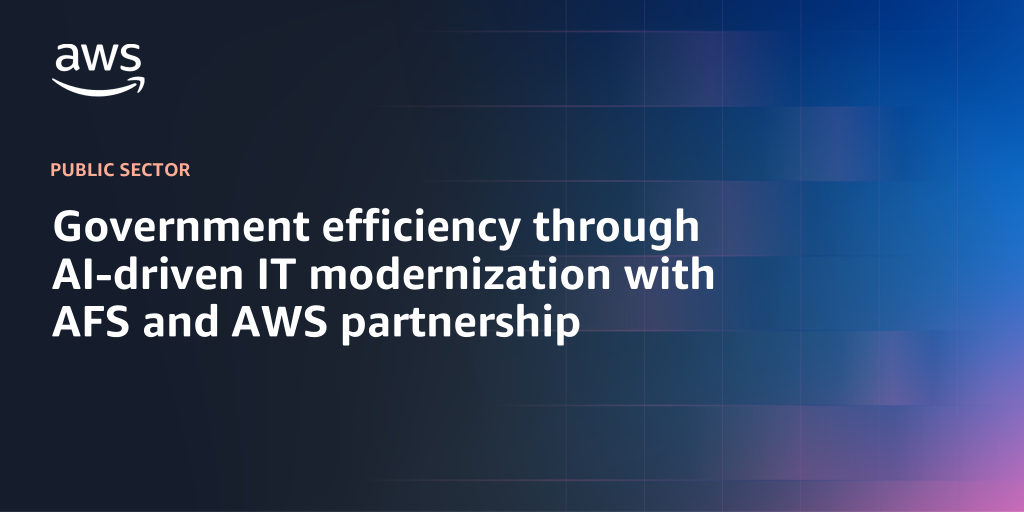AWS Public Sector Blog
Category: Amazon Comprehend
Government efficiency through AI-driven IT modernization with AFS and AWS partnership
Federal agencies are at a pivotal juncture in their technological evolution. Legacy systems, some dating back to the 1960s and 1970s, continue to power essential government services while facing a challenge: the retirement of the workforce that understands and maintains them. Rebecca Wetherly, director of worldwide public sector global system integrator partners at AWS recently sat down with Denise Zheng, chief AI officer at Accenture Federal Services (AFS), to discuss how artificial intelligence (AI) and modernization can help agencies navigate this transition while improving service delivery to citizens.
Transforming Resident Outreach using next-generation AI capabilities
Deloitte’s Resident Outreach solution (available in AWS Marketplace) enables state agencies to adapt their resident communications through the power of generative AI on AWS. In this post, we discuss how Deloitte empowers the four capabilities of Resident Outreach: Multi-Modal Completion of Applications & Renewals, Application Nudges, Correspondences, and Campaigns.
How Fair Trade USA uses AWS to improve working conditions for farmers
Fair Trade USA™ is a nonprofit organization that is committed to eliminating poverty by promoting sustainable development through ethical trade. They work to ensure fair compensation, safe working conditions for farmers and workers, and sustainable farming practices. In this post, you’ll learn how Fair Trade USA leverages Amazon Web Services (AWS) to improve working conditions for farmers and producers around the world.
Transforming government application systems using intelligent document processing on AWS
Government agencies handle vast volumes of bureaucratic documents daily, ranging from tax forms to medical records. This document-heavy workflow, often reliant on manual processing, can result in delays, errors, and increased operational inefficiencies, causing frustration among both employees and stakeholders. This post explores how intelligent document processing (IDP) solutions from Amazon Web Services (AWS) can modernize bureaucratic workflows, improve efficiency, and enhance service delivery within government agencies.
The benefits of an email-based AI virtual assistant on AWS
In today’s fast-paced and competitive business landscape, companies are constantly seeking ways to enhance efficiency, streamline operations, and provide top-notch customer service. Artificial intelligence (AI) has emerged as a powerful tool to help companies achieve these goals while revolutionizing the way they interact with customers. In this post, you can read about the transformative potential of email-based virtual assistants—a standout among AI applications—powered by Amazon Web Services (AWS).
Building your first generative AI conversational experience on AWS
Amazon Web Services (AWS) offers a variety of options for building chat-based assistants with generative artificial intelligence (AI) capabilities. The goal of this post is to present in simple words some of these options and what to keep in mind to decide which to use and how to get started.
How federal agencies can optimize document processing using advanced AI with human oversight
Federal agencies typically collect, manage, use, and distribute a wide array of documents. Storing and distributing federal agency documents is often a complicated process; documents can range from structured formats to free-flowing documentation with personal identifiable information (PII) that needs careful redaction. And because federal agencies cover a wide breadth of domains, it is challenging to develop a one-size-fits-all approach for document processing. In this post, we explore an example of how a federal agency can use Amazon Web Services (AWS) to design and deploy a solution that addresses this document processing challenge.
Microservices-based tax and labor systems using AWS
In Modernizing tax systems with AWS, we briefly touched upon infrastructure and application modernization using microservices and serverless architectures. We hear from multiple tax and labor agencies about their desire to move to API-based architectures and adopt new technologies. In this post, we dive deeper into these areas and discuss benefits, approaches, and best practices for building modern tax and unemployment insurance (UI) applications using microservices.
University Hospitals Coventry and Warwickshire NHS Trust digitizes and improves patient experience with AWS
Like many healthcare providers, University Hospitals Coventry and Warwickshire (UHCW) NHS Trust, which manages two major hospitals and serves a population of more than one million, has operated with legacy technology that relies heavily on phone calls and manual processes for contacting patients. Recognizing an opportunity to modernize, the Trust linked up with IBM Consulting for an innovative pilot project to digitize patient engagement channels using Amazon Web Services (AWS). Read this post to learn more.
EdTech innovator Sibme, powered by AWS, provides educators with AI-based instructional feedback
As a teacher with the KIPP charter school network in Houston, Texas, Dave Wakefield knew there had to be a better way for educators to gain insightful feedback on their instruction. Traditionally, educators who wanted feedback on their teaching either had to have someone visit their classroom or film themselves and then send that video to a mentor or peer for review. In 2013, Wakefield founded education technology (EdTech) company Sibme as a way to use technology, powered by Amazon Web Services (AWS), to help educators access quicker and more reliable feedback.









